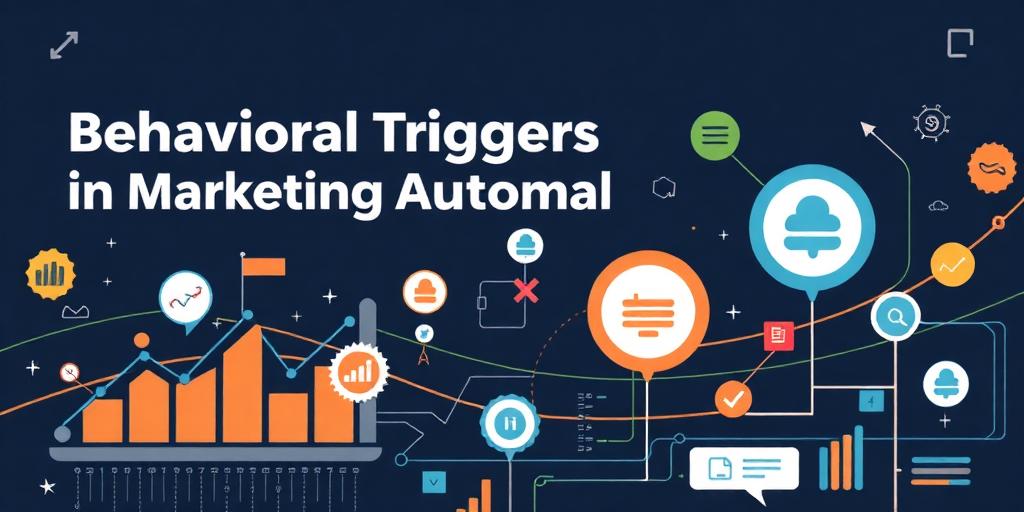Understanding Behavioral Triggers in Marketing Automation
In today's competitive digital landscape, marketing automation is no longer a luxury but a necessity. However, simply automating processes isn't enough. To truly maximize the impact of your marketing efforts, you need to understand and leverage behavioral triggers. These triggers are specific actions or patterns of behavior exhibited by your audience that, when identified, can initiate automated marketing responses. This article delves into the concept of behavioral triggers, their importance, and how to effectively implement them in your marketing automation strategy.
What are Behavioral Triggers?
Behavioral triggers are essentially signals that indicate a potential customer's interest, intent, or need. These signals can come in various forms, such as:
- Website Interactions: Visiting specific pages, downloading resources, or spending a certain amount of time on a page.
- Email Engagement: Opening emails, clicking on links, or unsubscribing from a list.
- Social Media Activity: Liking, sharing, or commenting on posts, or mentioning your brand.
- Purchase History: Making a purchase, abandoning a cart, or requesting a refund.
- Form Submissions: Filling out a contact form, requesting a demo, or signing up for a newsletter.
These actions provide valuable insights into your audience's preferences, pain points, and stage in the buyer's journey. By tracking and analyzing these behaviors, you can create more targeted and personalized marketing campaigns that resonate with your audience and drive conversions.
Why are Behavioral Triggers Important?
Implementing behavioral triggers in your marketing automation strategy offers several key benefits:
- Increased Relevance: By responding to specific actions, you can deliver content and offers that are highly relevant to each individual, increasing the likelihood of engagement.
- Improved Customer Experience: Personalized experiences demonstrate that you understand your audience's needs, fostering stronger relationships and building loyalty.
- Higher Conversion Rates: Targeted messaging and offers based on behavioral triggers can significantly improve conversion rates by guiding potential customers through the sales funnel more effectively.
- Enhanced Efficiency: Automation allows you to respond to behaviors in real-time, without manual intervention, saving time and resources.
- Data-Driven Insights: Tracking behavioral triggers provides valuable data that can be used to optimize your marketing campaigns and improve your understanding of your audience.
How to Implement Behavioral Triggers
Effectively implementing behavioral triggers requires a strategic approach. Here are some key steps to consider:
- Define Your Goals: Clearly define what you want to achieve with your marketing automation efforts. Are you looking to generate more leads, increase sales, or improve customer retention?
- Identify Key Behaviors: Determine the specific actions that indicate a potential customer's interest or need. Consider the different stages of the buyer's journey and the behaviors that are most relevant at each stage.
- Choose the Right Tools: Select a marketing automation platform that allows you to track and respond to the behaviors you have identified. Ensure the platform integrates with your existing systems, such as your CRM and website analytics.
- Create Automated Workflows: Design automated workflows that are triggered by specific behaviors. These workflows should include personalized messaging, relevant content, and targeted offers.
- Test and Optimize: Continuously monitor the performance of your automated workflows and make adjustments as needed. A/B testing different messaging and offers can help you optimize your campaigns for maximum impact.
Examples of Behavioral Triggers in Action
Here are some practical examples of how behavioral triggers can be used in marketing automation:
- Abandoned Cart: If a customer adds items to their cart but doesn't complete the purchase, trigger an email reminding them of their abandoned cart and offering a discount or free shipping.
- Website Visit: If a prospect visits a specific product page multiple times, trigger an email with a case study or testimonial highlighting the benefits of that product.
- Email Engagement: If a subscriber clicks on a link in an email, trigger a follow-up email with more detailed information or a special offer.
- Form Submission: If a lead fills out a contact form, trigger an automated email sequence that nurtures them with relevant content and invites them to schedule a call.
Conclusion
Behavioral triggers are a powerful tool for enhancing your marketing automation strategy. By understanding and responding to your audience's actions, you can deliver more relevant, personalized, and effective marketing campaigns that drive engagement, conversions, and customer loyalty. Implementing behavioral triggers requires careful planning, the right tools, and continuous optimization. However, the benefits of a well-executed behavioral trigger strategy are undeniable. By understanding and leveraging these triggers, you can transform your marketing automation from a simple process into a dynamic engine for growth.









